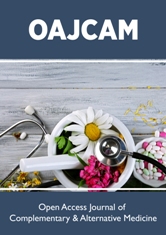
Lupine Publishers Group
Lupine Publishers
Menu
ISSN: 2644-1217
Case ReportOpen Access
Acupuncture Efficacy in Recurrent Miscarriage from PAI Type 1 Disorder: A Case Report Volume 4 - Issue 3
Jules Sonntag*
Department of Acupuncture, Pacific College of Health and Science, USA
Received: January 13, 2022 Published: January 23, 2022
*Corresponding author: Jules Sonntag, Department of Acupuncture, Pacific College of Health and Science, USA
DOI: 10.32474/OAJCAM.2023.04.000187
Keywords: Acupuncture, Miscarriage, Plasminogen Activator Inhibitor-Type 1
Case Report
According to the American Pregnancy Association (APA), an average of between “10 - 25% of all clinically recognized pregnancies will end in a miscarriage”, or spontaneous abortion. Most miscarriages occur within the first trimester, regardless of maternal age or para status. While most early losses occur due to chromosomal abnormality, other vectors can include hormonal issues, lifestyle factors, maternal trauma, and implantation problems. The hardest part for individuals experiencing Recurrent Miscarriage (RM) or Recurrent Pregnancy Loss (RPL), is the unknown factor. What is the source of the recurrent loss? Examination of the conceptus only supplies an answer 50% of the time. When a patient is utilizing Assisted Reproductive Technology (ART), there is significantly more testing performed on both the person who will be carrying it and the embryo(s) that will be implanted. Performing Frozen Embryo Transplants (FET) allow the ability to perform enhanced testing on all the cultivated embryos a patient may have to increase the chances of success and narrow the selection process.
In this case report, I will discuss patient R (she/her). She is a 39-year-old, nulliparous female with a history of RPL following multiple ART procedures. I began treating R in April of 2018, shortly before her first successful intra-uterine insemination (IUI) in June, at 37-years-old. She and her partner had been trying to conceive using ART/IUI for 6 months. I treated Liver Qi stagnation and blood stasis. She suffered an unexplained miscarriage at 10 weeks of gestation at the end of July. There was no evaluation of the conceptus. We continued weekly treatments with the same TCM diagnosis after a two-month recuperation period, and she became pregnant via
IUI again shortly after Thanksgiving, 2018. R miscarried a second time, in January, at 8 weeks pregnant and experienced multiple complications. At this point, she changed primary care providers and began working with a specialized clinic, focused on RM patients.
Her initial D&C was incomplete and required a second procedure to complete the removal of conceptus tissue in the second week of February 2019. Shortly afterward, in the beginning of March, R received a diagnosis of the adhesion condition, Asherman’s Syndrome, with an estimated 80% scarring on the uterus. We continued acupuncture to prepare for her histology and surgery for the condition in May 2019. This changed our protocols to include indirect moxibustion over the abdomen and castor oil compress over the lower abdomen three times a week, while at home. Scarring in the uterus was overestimated by 60%. Her ART practitioner put her on an enzyme supplement regimen to reduce scarring and encouraged her to continue acupuncture. In June she was diagnosed with PAI-1 disorder and started a blood-thinner regimen as prescribed by her ART doctor in preparation for FET. R responded well to standard low-stim IVF meds. Five embryos evaluated well and were frozen.
In preparing her acupuncture prescription to account for the poor methylation effect of PAI-1, first I researched the condition, itself. Khosravi, et al [1] investigated the impact of thrombophilia disorders in RM, including abnormal implantation or inability to sustain the development of the placenta. In particular, they were looking at the implications in cases with Plasminogen Activator Inhibitor Type 1 (PAI-1) and tissue plasminogen activator (t- PA) gene polymorphisms in otherwise healthy women trying to conceive. They found PAI-1 to have a contribution in early pregnancy loss. Ye, et al further investigated with their review in 2017, “Role of Plasminogen Activator Inhibitor Type 1 in Pathologies of Female Reproductive Diseases” and confirmed “PAI-1 levels are increased in patients with recurrent pregnancy losses (RPL)…” (Ye [2]).
Regarding acupuncture research, I found the work of Takayama, et al. [3] to be most helpful for the best point to increase blood flow to the uterus. The paper evaluates the effect of acupuncture on blood flow and verified its impact using ultrasound color Doppler imaging. Upon evaluation of Stomach 36, the researchers found “blood flow volume in the superior mesenteric artery (SMA) increased significantly” (Takayama, 2012, p.6). I am profoundly conservative when working with RM patients and follow rather strict guidelines, as I was taught by my mentor, regarding number of needles and restrictions of placement. Due to these parameters, I’m looking for the best three points; no more than six needles as soon as there’s even a chance of pregnancy. R had regular weekly acupuncture throughout all of July 2019 with points Yin Tang, ST 36, LV 3, Ren 4 and 6, GB 41 and SJ 5 as a base. Additional auricular points were chosen with each treatment for attendant anxiety and PTSD-like symptoms due to RM trauma. R was cleared by her ART practitioner for FET in the second week of August and successfully conceived again. Her prescription was modified to account for possible pregnancy directly after the FET to DU 20, LU 7, and ST 36. We stopped using auricular points at this time. She experienced spotting at 7 weeks, and I modified her points to DU 20 and 24, LU 7 and LV5. Needle insertion at LV 5 was upward, with strong tonifying technique. Her spotting resolved and we continued back with DU 20 and 24, LU 7 and ST 36 from 9 weeks forward. Modifications were minimal; ST 36 was replaced with ST 44 for symptomatic heartburn relief as R entered into the third trimester.
Discussion
R delivered her baby daughter at the end of April 2020. The research looking into the impact of PAI-1 in RM was very helpful in understanding the physical manifestations of the syndrome. It helped me extrapolate that information into an East Asian Medicine (EAM) etiology and pattern diagnosis. R and her wife attribute their successful outcome to the addition of acupuncture to the ART. By combining information on biomedical research with evidence-based acupuncture research regarding specific efficacy of Stomach 36, I was able to construct an appropriate supportive point prescription for this patient. Patients with RM are especially vulnerable to emotional stress, depression, and ruminating thoughts. Many patients present with some symptoms of PTSD, as in the case of R. Using acupuncture to alleviate these impacts without necessitating further pharmacological interventions is profoundly helpful in improving pregnancy outcomes.
References
- Khosravi F, Zarei S, Ahmadvand N, Akbarzadeh-Pasha Z, Savadi E, et al. (2014) Association between plasminogen activator inhibitor 1 gene mutation and different subgroups of recurrent miscarriage and implantation failure. Journal of assisted reproduction and genetics 31(1): 121–124.
- Ye Y, Vattai A, Zhang X, Zhu J, Thaler C J, et al. (2017) Role of Plasminogen Activator Inhibitor Type 1 in Pathologies of Female Reproductive Diseases. International journal of molecular sciences 18(8): 1651.
- Takayama S, Watanabe M, Kusuyama H, Nagase S, Seki T, et al. (2012). Evaluation of the effects of acupuncture on blood flow in humans with ultrasound color Doppler imaging. Evidence-based complementary and alternative medicine pp. 513638.

Top Editors
-

Mark E Smith
Bio chemistry
University of Texas Medical Branch, USA -

Lawrence A Presley
Department of Criminal Justice
Liberty University, USA -

Thomas W Miller
Department of Psychiatry
University of Kentucky, USA -

Gjumrakch Aliev
Department of Medicine
Gally International Biomedical Research & Consulting LLC, USA -

Christopher Bryant
Department of Urbanisation and Agricultural
Montreal university, USA -

Robert William Frare
Oral & Maxillofacial Pathology
New York University, USA -

Rudolph Modesto Navari
Gastroenterology and Hepatology
University of Alabama, UK -

Andrew Hague
Department of Medicine
Universities of Bradford, UK -

George Gregory Buttigieg
Maltese College of Obstetrics and Gynaecology, Europe -

Chen-Hsiung Yeh
Oncology
Circulogene Theranostics, England -
.png)
Emilio Bucio-Carrillo
Radiation Chemistry
National University of Mexico, USA -
.jpg)
Casey J Grenier
Analytical Chemistry
Wentworth Institute of Technology, USA -
Hany Atalah
Minimally Invasive Surgery
Mercer University school of Medicine, USA -

Abu-Hussein Muhamad
Pediatric Dentistry
University of Athens , Greece

The annual scholar awards from Lupine Publishers honor a selected number Read More...




